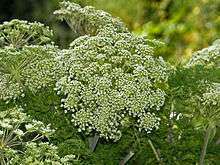Selinum tenuifolium
| Selinum tenuifolium | |
|---|---|
 | |
| Selinum tenuifolium at the Orto Botanico di Brera, Milano | |
| Scientific classification | |
| Kingdom: | Plantae |
| (unranked): | Angiosperms |
| (unranked): | Eudicots |
| (unranked): | Asterids |
| Order: | Apiales |
| Family: | Apiaceae |
| Genus: | Selinum |
| Species: | S. tenuifolium |
| Binomial name | |
| Selinum tenuifolium Wall. ex C.B. Clarke | |
| Synonyms | |
| |
Selinum tenuifolium is a flowering plant of the genus Selinum in the family Apiaceae. N.B. the current version of The Plant List lists the correct name of this plant as S. wallichianum and S. tenuifolium as a synonym - and not vice versa as given on this page.
Description
Selinum tenuifolium can reach a height of 3–6 feet (0.91–1.83 m). It is a long-lived, tuberous-rooted, perennial plant bearing large umbels of thousands of tiny five-petalled white flowers from midsummer to early autumn. The delicate basal leaves are thin (hence the specific name tenuifolium - 'thin-leaved') and finely divided, giving them a fern-like appearance. The plant is grown as a hardy garden ornamental, suitable for informal mixed or shrub borders or woodland gardens, and is effective grown as a specimen plant to display to advantage the tiered effect of its attractive floral umbels.[1]
Distribution
The plant occurs in the Himalayas from India, Nepal, Kashmir and W. Pakistan to Bhutan.[2]
Habitat
Selinum tenuifolium is found in the wild growing among shrubs and also upon open slopes at an elevation of about 13,000 feet (4,000 m).
Common Names
The plant is known in Bhutan as Bam-po, while in India it bears the names Bhootheshi, Bhootkeshi, Dhoopkesh, Kher and Khishan.
Uses in Folk Medicine and Ritual
The plant, like many others belonging to the family Apiaceae, is aromatic - particularly the root. The fruits (of the mericarp type) have sedative (see also anxiolytic) and aphrodisiac properties and are also used to treat rheumatism and kidney disease. The roots are used to treat abdominal pain (- many Apiaceous plants possess carminative properties, relieving bloating -) and also as a sedative in the treatment of 'hysteria' and 'madness' - particularly when these conditions occur in women (see also Culture-bound syndrome). The whole plant features in traditional magico-religious beliefs of the Himalayan region, being used to prepare dhoop (incense) for ceremonial use. More specifically, the powdered root is used as a fumigant in Tantric rituals intended to cure insanity, nervous breakdown and 'hysteria'.[3] The above uses suggest that preparations of the plant are capable of exerting effects upon the Central nervous system and Genitourinary system and that the plant may be mildly psychoactive, bearing comparison with the related Apiaceous plant Ferula moschata - another umbellifer with a long history of use in India to treat 'hysteria' and as a ritual incense and one which has been observed, on occasion, to elicit narcotic effects.[4] Folk-medicinal uses eliciting psycho-sexual effects further invite comparison with another Ferula species, namely Ferula hermonis, considered, like Selinum tenuifolium, to possess aphrodisiac properties.[5]
References
- ↑ The Royal Horticultural Society A-Z Encyclopedia of Garden Plants Editor-in-Chief Christopher Brickell, pub. Dorling Kindersley 1996, reprinted 1997, ISBN 0-7513-0303-8 page 952.
- ↑ Polunin, Oleg and Stainton, Adam, Flowers of the Himalaya, pub. Oxford University Press 1984, page 157 and illustration on plate 51, of plant growing in Ganesh Himal range, Central Nepal.
- ↑ Quattrocchi, Umberto (2012). CRC World dictionary of medicinal and poisonous plants: common names, scientific names, eponyms, synonyms and etymology. Volume 5 R-Z. CRC Press Taylor and Francis Group, page 228.
- ↑ Grieve, Mrs. M. A Modern Herbal , first published 1931,Jonathan Cape Ltd.,reprinted 1974 and 1975. pps. 781-2.
- ↑ Graham White, National Institute of Medical Herbalists, Ferula hermonis "The Lebanese Viagra" by Stuart FitzSimmons